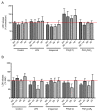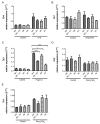Titanium Surface Characteristics Induce the Specific Reprogramming of Toll-like Receptor Signaling in Macrophages
- PMID: 35457102
- PMCID: PMC9030374
- DOI: 10.3390/ijms23084285
Titanium Surface Characteristics Induce the Specific Reprogramming of Toll-like Receptor Signaling in Macrophages
Abstract
Most of the research on titanium-based dental implants (Ti-discs) is focused on how they are able to stimulate the formation of new tissue and/or cytotoxic studies, with very scarce data on their effects on functional responses by immunocompetent cells. In particular, the link between the rewiring of innate immune responses and surface biomaterials properties is poorly understood. To address this, we characterize the functional response of macrophage cultures to four different dental titanium surfaces (MA: mechanical abrasion; SB + AE: sandblasting plus etching; SB: sandblasting; AE: acid etching). We use different Toll-like receptor (TLR) ligands towards cell surface receptors (bacterial lipopolysaccharide LPS for TLR4; imiquimod for TLR7; synthetic bacterial triacylated lipoprotein for TLR2/TLR1) and endosomal membrane receptor (poly I:C for TLR3) to simulate bacterial (cell wall bacterial components) or viral infections (dsRNA and ssRNA). The extracellular and total LDH levels indicate that exposure to the different Ti-surfaces is not cytotoxic for macrophages under resting or TLR-stimulated conditions, although there is a tendency towards an impairment in macrophage proliferation, viability or adhesion under TLR4, TLR3 and TLR2/1 stimulations in SB discs cultures. The secreted IL-6 and IL-10 levels are not modified upon resting macrophage exposure to the Ti-surfaces studied as well as steady state levels of iNos or ArgI mRNA. However, macrophage exposure to MA Ti-surface do display an enhanced immune response to TLR4, TLR7 or TLR2/1 compared to other Ti-surfaces in terms of soluble immune mediators secreted and M1/M2 gene expression profiling. This change of characteristics in cellular phenotype might be related to changes in cellular morphology. Remarkably, the gene expression of Tlr3 is the only TLR that is differentially affected by distinct Ti-surface exposure. These results highlight the relevance of patterned substrates in dental implants to achieve a smart manipulation of the immune responses in the context of personalized medicine, cell-based therapies, preferential lineage commitment of precursor cells or control of tissue architecture in oral biology.
Keywords: Toll-like receptors; dental implants; immune regulation; macrophage cells; surfaces; titanium discs.
Conflict of interest statement
The authors declare no conflict of interest.
Figures








Similar articles
-
Toll-like receptors and their adaptors are regulated in macrophages after phagocytosis of lipopolysaccharide-coated titanium particles.J Orthop Res. 2011 Jul;29(7):984-92. doi: 10.1002/jor.21369. Epub 2011 Feb 9. J Orthop Res. 2011. PMID: 21308757
-
Ligand-regulated chimeric receptor approach reveals distinctive subcellular localization and signaling properties of the Toll-like receptors.J Biol Chem. 2004 Apr 30;279(18):19008-17. doi: 10.1074/jbc.M311618200. Epub 2004 Feb 19. J Biol Chem. 2004. PMID: 14976215
-
A role for microRNA-155 modulation in the anti-HIV-1 effects of Toll-like receptor 3 stimulation in macrophages.PLoS Pathog. 2012 Sep;8(9):e1002937. doi: 10.1371/journal.ppat.1002937. Epub 2012 Sep 20. PLoS Pathog. 2012. PMID: 23028330 Free PMC article.
-
TLRs: Innate Immune Sentries against SARS-CoV-2 Infection.Int J Mol Sci. 2023 Apr 29;24(9):8065. doi: 10.3390/ijms24098065. Int J Mol Sci. 2023. PMID: 37175768 Free PMC article. Review.
-
Role of toll-like receptors 3, 4 and 7 in cellular uptake and response to titanium dioxide nanoparticles.Sci Technol Adv Mater. 2013 Mar 7;14(1):015008. doi: 10.1088/1468-6996/14/1/015008. eCollection 2013 Feb. Sci Technol Adv Mater. 2013. PMID: 27877566 Free PMC article. Review.
Cited by
-
Topography-based implants for bone regeneration: Design, biological mechanism, and therapeutics.Mater Today Bio. 2025 Jul 13;34:102066. doi: 10.1016/j.mtbio.2025.102066. eCollection 2025 Oct. Mater Today Bio. 2025. PMID: 40735704 Free PMC article. Review.
-
The Characterization of Titanium Particles Released from Bone-Level Titanium Dental Implants: Effect of the Size of Particles on the Ion Release and Cytotoxicity Behaviour.Materials (Basel). 2022 May 19;15(10):3636. doi: 10.3390/ma15103636. Materials (Basel). 2022. PMID: 35629663 Free PMC article.
-
Topography-mediated immunomodulation in osseointegration; Ally or Enemy.Biomaterials. 2022 Dec;291:121903. doi: 10.1016/j.biomaterials.2022.121903. Epub 2022 Nov 9. Biomaterials. 2022. PMID: 36410109 Free PMC article. Review.

